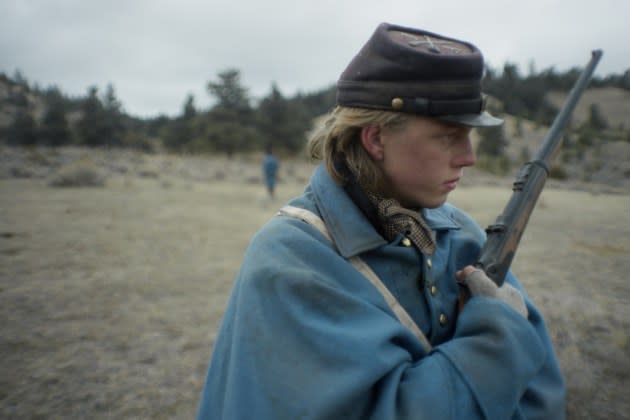‘The Damned’ Review: In His Latest Look at America’s Margins, Roberto Minervini Travels Back to the Civil War

Set during the Civil War, a long way from the front lines, Roberto Minervini’s “The Damned” continues the Italian helmer’s career-long examination of the rifts and affinities between overlooked segments of American society. Apart from one long, destabilizing battle with an unseen adversary, the portrayal is a relatively peaceful one, following a group of Union soldiers assigned to scout the Northwestern frontier in 1862. While the country is divided, this assignment brings together men of different backgrounds, fostering camaraderie and mutual respect (surprisingly, the topic of slavery never comes up, though God factors into multiple conversations).
This is the first period piece from the director of such unvarnished depictions of contemporary Southern life as “Stop the Pounding Heart” and “The Other Side,” and yet the quiet, occasionally poetic film feels like a natural extension of the themes and approach of Minervini’s earlier work. Even within the art-house sphere, it’s a bit too thin and plotless for most audiences. (I chuckled when I saw the closing “story by” credit, since I hadn’t detected much of a story until that point.) Still, “The Damned” makes a welcome addition to an oeuvre consistently attuned to the way Americans think about faith, class and community, whether or not the Americans in question realize it themselves.
More from Variety
During the film’s first half-hour, we get glimpses into the scouts’ daily lives, as they tramp across the frontier, coming together to push a covered wagon up a steep hill … in search of what? Their mission is vague, described only by a bit of on-screen text at the outset. One man, slightly older and more experienced, prospects for gold. When not on the move, they cluster around the campfire, drinking coffee from leaky cups. The in-character conversation feels naturalistic and unscripted, guided by Minervini’s desire to explore earlier forms of the tensions and beliefs that shape American identity.
Geographically, the film takes him far from Southern corners that have interested him before, trading Texas backwoods and Louisiana swamps for the wilds of Montana. A slow-motion opening sequence shows wolves tearing into a deer carcass, suggesting a potential for danger or violence upon which the film never quite delivers. The cold ultimately proves as deadly to these Union volunteers as their Confederate rivals, as reflected in one of the film’s most haunting scenes: Two corpses lie frozen in the snow, while their horse struggles to free itself from the line to which it’s been tied.
With their full beards and blunt features, the men in Minervini’s cast look less like professional actors than the authentic Civil War soldiers seen in daguerreotypes of the time (especially Tim Carlson, of the family featured in “Stop the Pounding Heart,” as the Sergeant). Characters have a way of drifting in and out of Minervini’s films, and “The Damned” is no different, despite its more structured premise. A select group of troops travel to Montana, bonding among themselves for a time, before a run-in with Confederate snipers drastically reduces their ranks.
Minervini’s style has always blurred the lines between documentary and fiction, and here — in Civil War reenactment mode, as participants play themselves in period garb — he covers the ambush the way a war photographer might. DP Carlos Alfonso Corral, who shot Minervini’s striking black-and-white doc “What You Gonna Do When the World’s on Fire?,” chases after the soldiers as they duck for cover and attempt to return fire. Hidden by distant bushes, the enemy remains unseen, which makes the conflict that much more disconcerting.
Does “The Damned” really qualify as a war film? At times, the low-key approach may remind viewers more of Kelly Reichardt’s Oregon Trail saga, “Meek’s Cutoff,” in that both films (set less than two decades and two states apart) provide an alternative to the conventional Hollywood Western. For instance, “The Damned” doesn’t even bother to identify the names of its characters, rejecting the 20th-century focus on the individual — where heroic characters might be played by John Wayne or Henry Fonda — in favor of a collective sea of faces.
That’s something so many war movies get wrong: When men enlist in the Army, they agree to put the cause ahead of themselves. It becomes their duty to accept orders, however counterintuitive, whereas in Hollywood movies (of the past 50 years, at least), authority is nearly always wrong, and success is only possible when someone steps out of line and does what’s right. In reality, such behavior would almost surely get the fanatic (and many of his comrades) killed.
In a challenge to America’s own mythology, Minervini dispenses with such tropes, while allowing his characters — including a fresh-faced teen known only as ”Young Soldier” (Judah Carlson) — space to reflect on their reasons for signing up. They question the existence of God, debate the ideas of good and evil, and try to make sense of their mounting disillusion. “The Damned” has a tendency to meander, but in so doing, it strives toward something authentic.
Best of Variety
Sign up for Variety’s Newsletter. For the latest news, follow us on Facebook, Twitter, and Instagram.
